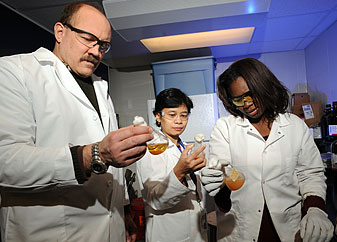Scientists eye natural products for food safety, human health

Graduate student Demaris Meujo (right), Mark Hamann (left) and others
developed a technique to make raw oysters safer to eat.
harmacy Professor Mark T. Hamann and his research team have spent more than two decades discovering new drug leads from marine organisms and plants with the goal of strengthening the world’s arsenal for fighting cancer, neurological disorders, drug-resistant staff infections and infectious diseases such as malaria and tuberculosis.
Recently, the team expanded its explorations to include identifying and characterizing leads for the food industry. Kraft Foods has provided support for the team’s work.
Working to identify compounds of benefit to the food industry isn’t a “significant stretch” from searching for drugs to treat infectious diseases, Hamann said.
‘Filter-feeding animals such as oysters and clams, as well as other species like shrimp, lobsters and fish, can
act as a reservoir and
be contaminated
with pathogenic microorganisms.’
graduate student
Demaris Meujo
“This is actually a nice and highly productive direction for us, because our antibiotic leads that kill bacteria but perhaps degrade in the GI (gastrointestinal) system may have newfound potential as agents in food safety,” he said. “The bioassays are slightly different, so we had to establish a few new techniques appropriate for foods.”
The Centers for Disease Control and Prevention estimates that culprits such as Salmonella, E. coli, Clostridium botulinum and other microorganisms cause 76 million illnesses annually in the United States. This past summer, the CDC traced a multistate outbreak of E. coli infections to a large Nebraska beef processor, resulting in a nationwide recall. So, too, did an outbreak traced to an Iowa producer’s Salmonella-laced eggs that the CDC has linked to approximately 1,813 illnesses.
A tremendous market exists for natural products or methods to ensure our food is safe and for additives with a wide variety of health benefits, and the need for these types of products will not likely diminish in the foreseeable future, Hamann said. Due to the magnitude of the work, a bevy of students, research fellows and visiting scholars are involved.
Among them is graduate student Demaris Meujo, who helped develop a technique to kill bacteria associated with oysters.
“Filter-feeding animals such as oysters and clams, as well as other species like shrimp, lobsters and fish, can act as a reservoir and be contaminated with pathogenic microorganisms,” Meujo said. “Since oysters are often consumed raw, these pathogens are a serious concern.”
The pathogens include everything from hepatitis viruses to a plethora of bacteria and parasites. They accumulate in digestive tracts of mollusks and can cause mild to severe illness and even death in humans. Several post-harvest processing methods reduce the risk but kill the oysters.
With funding from the Mississippi-Alabama Sea Grant Consortium, Meujo and Hamann developed a new and promising approach. They simply expose oysters to carbon dioxide in supercritical state (gas-liquid) and “cool pasteurize” them.
“Our research indicates treated oysters taste, smell and look exactly like fresh oysters, but treating them removes 90 to 95 percent of the bacteria,” said Meujo, coauthor of a chapter on seafood safety in Environmental Toxicology–Encyclopedia of Sustainability Science and Technology. Work on the cool pasteurization technique is published in a recent issue of the International Journal of Food Microbiology (volume 138, 2010, 63-70).
The food industry also needs natural additives with a variety of applications, said James Sims, a postdoctoral research associate working in Hamann’s laboratory with support from Kraft Foods and the National Institute of Allergy and Infectious Diseases. Additives include substances that can further improve the quality and enjoyment of foods.
Some of those substances may one day be derived from the marine organisms Hamann and his colleagues have long been studying. Sponges and corals produce compounds to fend off fungal infections, predators and bacterial invaders. Graduate students John Bowling, Amanda Waters, Amir Wahba and others are probing these compounds for use against food-borne, communicable and genetic diseases. The trick is to harness their biochemical power while reducing their toxicity.
Helping conduct the research are graduate students Bin Wang, Joonseok Oh and Samuel Abbas; microbiologist Yan Xia, a visiting scholar from China; chemistry major Kamilla Alves; and Lafayette High School students Alexis Fullmer and Serena Ellison.
“It’s exciting to see some of the things we’ve been working on show real potential to help save lives or keep people from becoming ill, but equally rewarding is training the next generation of scientists, researchers and college instructors,” Hamann said. “Many who have worked in our laboratories have become faculty members at universities throughout the country and abroad, or hold leadership positions with major pharmaceutical companies.”
|

